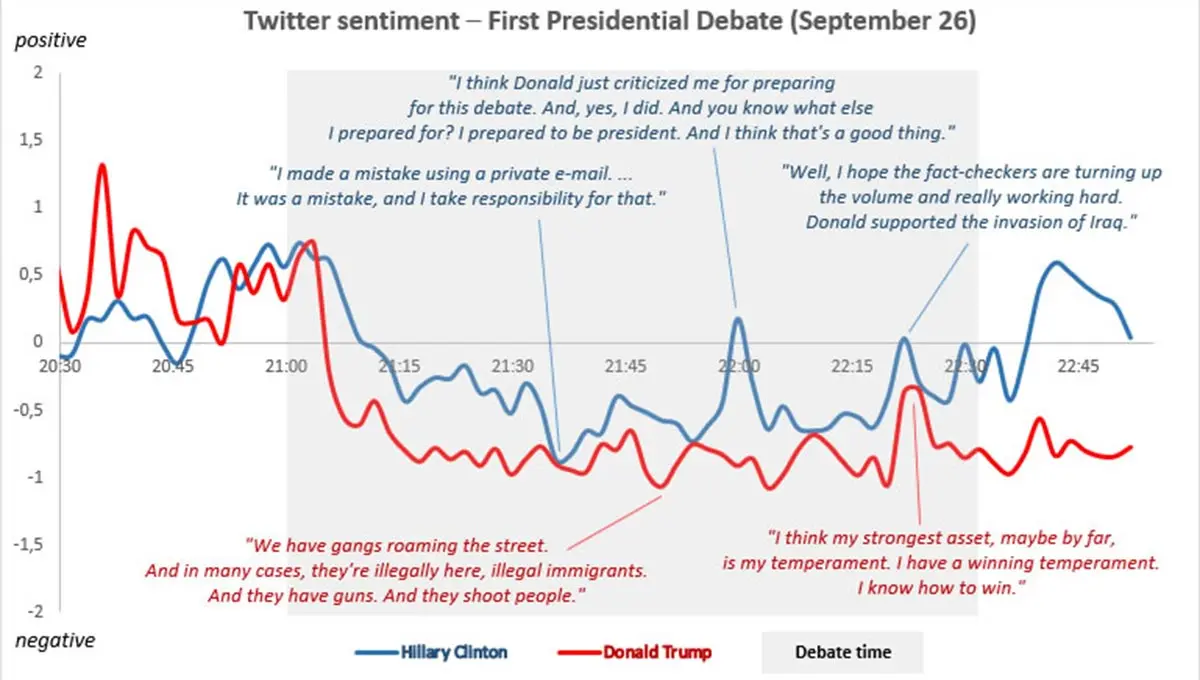See Results in Real Time at HillaryDonald.com

10/18/2016
By Edwin L. Aguirre
A team of researchers from UMass Lowell and Dartmouth College has developed two new tools that allow users nationwide to react and view responses to the debates and other election events of the 2016 presidential election campaign in real time. The tools include HillaryDonald, a free interactive app that enables users to remotely “applaud” or “boo” live remarks by Hillary Clinton and Donald Trump in real time, and TwitterScope, a visualization tool that maps live political discourse on Twitter by ideology and sentiment.
Through the HillaryDonald app, users can show their approval or disapproval of live political discussion by simply tapping a thumbs-up (or thumbs-down) icon on their smartphone’s screen and shaking their phones when they like (or dislike) something a candidate says. Users’ remote applause or boos are then accumulated and visualized as a graph or map on HillaryDonald.com. The app is available for free through the App Store and Google Play.
“These tools serve as a continuous real-time survey that measures the current pulse of the nation’s political sentiment toward the two candidates as well as on hot topics such as abortion, immigration, guns and taxes,” says UMass Lowell computer science Asst. Prof. Anna Rumshisky, who is director of the university’s Text Machine Lab for Natural Language Processing. She provided computational linguistics and data-mining expertise for HillaryDonald.com.
“It’s a great way of looking at people’s reaction to Clinton and Trump in real time, not only as they go through their talking points but also the candidates’ actions, expressions, gestures and body language while on stage,” notes Rumshisky. “Before we developed these tools, we believe there has been no way to track people’s emotional reaction live.”
The graph below plots the users’ tweets from the first presidential debate, held Sept. 26.
“TwitterScope shows the average political sentiment of the users. The program automatically assigns a value for each tweet — positive for favorable sentiment and negative for unfavorable. The amplitude, or height, of the graph does not represent the actual number of tweets, but rather the intensity of the expressed sentiment,” explains Rumshisky. It’s interesting to note that prior to the debate, users were expressing more positive sentiment toward Trump, but after the debate, it was Clinton who was viewed positively.
Rumshisky says that while the tool assigns political orientation to known journalists and politicians, it’s not possible to distinguish for the tweets that come from the general public. “It’s also not possible to pull enough demographic information from Twitter. Generally, most people don’t make their location, gender, age or party affiliation public. And those that do, you can’t tell whether the information is accurate or reliable,” she says.
Can the HillaryDonald app help the undecideds?
“The app is not designed to influence the undecided voters,” says Rumshisky. “However, they can look at the graph and see how people reacted to certain statements made by the candidates during the debate; which ones generated the most positive, or most negative, public sentiment. They can then take a closer look at those issues and gather more information about them.”
Rumshisky and her co-researchers, Mikhail Gronas and Joseph Bafumi at Dartmouth College, are currently analyzing data from the second debate. Go to HillaryDonald.com for the latest updates.





